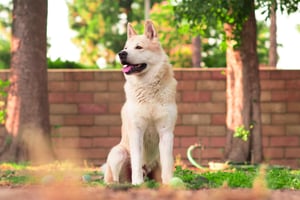Dogs are usually known to be loyal and loving companions, but they can become aggressive in certain...
Dog Training for Aggressive Dogs: A Comprehensive Guide
Dog aggression is a serious issue that requires specialized training and understanding. This guide provides an overview of the causes of aggression in dogs and offers effective dog training techniques to help your furry friend become a happy, healthy, and well-behaved pup. Read on to learn more about dog training for aggressive dogs and how to ensure your pet’s safety and wellbeing.
What is Dog Aggression?
Dog aggression is an expression of negative behaviour commonly seen in canines. This can manifest in different ways, from growling and barking to snapping and biting. Aggression can be caused by a variety of factors, such as fear, dominance, possessiveness, territoriality, or a lack of socialization.
It’s important to note that aggression is a natural behaviour in dogs, and that it’s not necessarily a sign of an untrainable or “bad” dog. In fact, aggression can be managed and even eliminated with proper training and understanding.
The Causes of Dog Aggression
The cause of aggression in dogs can vary from one pup to another. However, there are some common causes that are important to understand in order to better address the issue.
Fear: Fear-based aggression is the most common type of aggression in dogs. This can occur when a pup feels threatened or is exposed to a situation that makes them scared or uncomfortable.
Dominance: Dominance-related aggression is common in dogs that are trying to assert their authority in the household. This can be seen when a pup is possessive over toys or food, or when they become aggressive towards other animals or people.
Territoriality: Territorial aggression is seen when a pup is trying to protect their territory or the people they consider as part of their family. This can manifest in different ways, such as barking when visitors come over or growling when another animal enters the house.
Lack of Socialization: Dogs that are not properly socialized or exposed to different people and animals are more likely to become aggressive. This is because they are not used to being around different animals or humans, and may become scared or defensive when exposed to these situations.
Dog Training Techniques for Aggressive Dogs
There are a variety of dog training techniques that can help reduce aggression in dogs. Here are some of the most effective methods to keep in mind:
- Positive Reinforcement: Positive reinforcement is one of the most effective techniques for training dogs. This involves rewarding good behaviour with treats, praise, and playtime. This encourages the dog to repeat the desired behaviour and discourages them from engaging in negative behaviour.
- Behaviour Modification: Behaviour modification involves changing the way a dog reacts to certain stimuli. For example, if a dog is aggressive towards other animals, it can be taught to remain calm and relaxed when exposed to them.
- Desensitization: Desensitization is a technique that involves exposing the dog to the thing they are afraid of in a controlled and gradual manner. This helps them become more comfortable with the stimulus and reduces the chances of them becoming aggressive.
- Obedience Training: Obedience training is an important part of dog training for aggressive dogs. This helps the pup learn basic commands such as “sit”, “stay”, and “come”, and ensures that they respond to these commands when necessary.
It’s important to note that dog training for aggressive dogs is a process that requires patience, understanding, and consistency. It’s also important to remember that no two dogs are the same, and that each pup will require a different approach.
Tips for Training Aggressive Dogs
Here are some tips to keep in mind when training aggressive dogs:
- Be Patient: Training an aggressive dog can be difficult and time-consuming. It’s important to remain patient and consistent with the training process in order to ensure success.
- Set Clear Expectations: Setting clear expectations for your pup is important for successful training. Make sure your pup understands what is expected of them and what behaviour is not acceptable.
- Stay Calm: When dealing with aggressive behaviour, it’s important to stay calm and not react with anger or aggression. This will only make the situation worse and could lead to more aggressive behaviour.
- Reward Good Behaviour: Rewarding good behaviour is an important part of training an aggressive dog. Make sure to reward your pup with treats and praise when they display the desired behaviour.
- Seek Professional Help: If you’re having trouble training your pup, it’s important to seek professional help. A qualified dog trainer or behaviourist can provide effective techniques and guidance to help address the issue.
Conclusion
Dog aggression is a serious issue that requires specialized training and understanding. This guide provided an overview of the causes of aggression in dogs and offered effective dog training techniques to help your furry friend become a happy, healthy, and well-behaved pup.
Remember, dog training for aggressive dogs requires patience, consistency, and understanding. It’s important to set clear expectations, stay calm, and reward good behaviour. If you’re having trouble training your pup, it’s important to seek professional help.
With the right approach, you can help your pup become a happy, healthy, and well-behaved pup.



